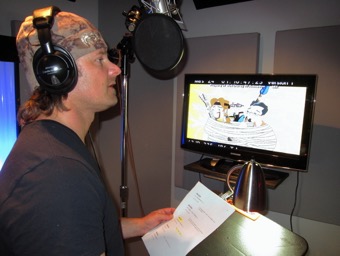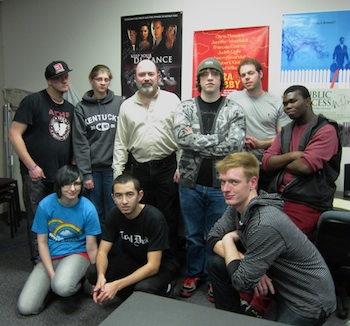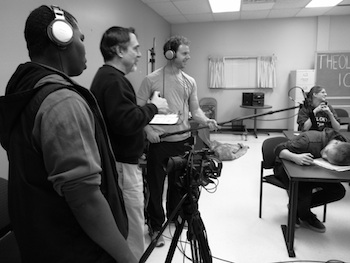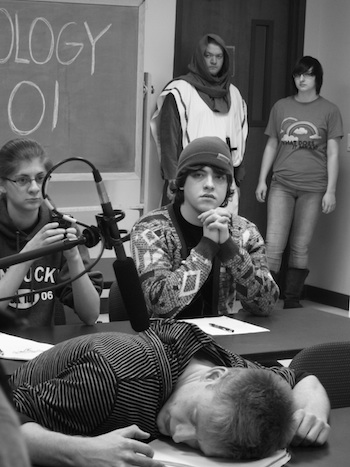

- © 2003 - 2024 Dynamix Productions, Inc. Contact Us 0


Replacing Dialog in Videos
 Steve Zahn performing ADR for Disney's "Phineas & Ferb"
Steve Zahn performing ADR for Disney's "Phineas & Ferb"
Replacing dialog in video and film has come a long way since Clint Eastwood had to dub dialog for his spaghetti westerns. Whether it's noise in the original track, a changed or new line, or even a different performance, replacing dialog on programs and films is commonplace today. In the old days, the actor watched a film loop of the scene and performed the new lines. One common way to create the loop was to tape a film's end to the beginning, thus making a continous loop. Another common approach was to just play the original dialog over and over while the actor mimicked the line. Each of these methods required hours if not days of preparation. The ADR (automated dialog replacement) stage became popular as computer automation became available. Custom-built audio consoles could automatically cue up scenes and insert countdown cues for the actor while recording multiple takes in succession. But all of this still required time to set up and execute because of optical film and analog audio limitations.
Enter the DAW, or digital audio workstation. Although music recording pushed the earliest programming efforts for DAW software, audio for film and video was right on its heels. One could "spot" (precisely place a sound cue at a particular point in the timeline) dialog and sound effects with even the earliest DAWs in the mid 1990s. Today, ADR has moved out of specialized studios in Hollywood and into average studios around the world. Studios like Dynamix Productions, where our core business is not ADR, can now record and deliver ADR in one session, post a video the next, and finish up the day producing a radio commercial. Actors love it because they don't always have to fly to an ADR stage location anymore - just hop over to Dynamix! The workflow is just a fraction of what it used to be thanks to digital video, fast internet, and ISDN. In January alone, we engineered four ADR sessions, one of which aired on NBC primetime just 5 days later. So the next time you're watching your favorite drama or movie, listen to the dialog - it may have been recorded in Hollywood AND Lexington.
Dynamix Tech Notes
Actor in Lexington, director in L.A. Both are watching the same video, hearing the same sound - at the same time. How? The miracle of time code and ISDN. When an actor is in a different location from the director and performing ADR, each must see and hear the same thing at the same time. Last month we visited ISDN and learned that it is a real-time bi-directional digital audio connection between studios. One incredible feature of ISDN is its multi-channel capability. By sending the actor's microphone down one channel of the ISDN, and video time code down the other, both studios can "lock up" together.
Here's how it works:
Our studio serves as the MASTER, and the L.A. studio serves as the SLAVE in this synchronization process.
The studio in L.A. sends a Quicktime video file to Dynamix in Lexington. Now both studios have the same exact video. This video file has time code (or SMPTE, information about each video frame) both embedded into the data as well as imprinted on the screen.
The video is imported into both studios' DAWs.
Our DAW reads the time code information on the video and can output the SMPTE information as audio (it sounds like a swarm of flying insects). This audio is sent down the right channel of the ISDN connection.
The L.A. studio routes the incoming SMPTE audio from the right channel of the ISDN into the DAW.
The SMPTE audio is read as time code as the L.A. DAW "chases" to our DAW. In other words, if Lexington starts playing at 1 hour, 32 mintues, 16 seconds and 4 frames (01:32:16:04), then the L.A. DAW starts playing at that same exact time.
Both studios record the actor's lines in time with the video. In Lexington, we record an extra track with an additional microphone. We then send all the files to L.A. for post-production.
Recent Projects From Dynamix Productions
ADR with Kevin Pollak for "Law & Order: SVU" (Wolf Films, NBC Universal)
ADR with Steve Zahn for "Treme" (Fee Nah Nay, HBO)
ADR with Steve Zahn for "Diary of a Wimpy Kid: Dog Days" (Fox Entertainment, 20th Century Fox)
ADR with Steve Zahn for "Phineas & Ferb" (Disney)
Ongoing post production for Office Depot distribution centers safety training videos (PCG Solutions, Lexington, KY).
Presentation video for Mohammad Ali's 70th Birthday celebration (Grayhorse Productions, Lexington, KY).
"Corner Booth" interview with musician/songwriter Robert Beatty. Sponsored by Dynamix Productions,LAMA, and WEKU-FM.
Republic Bank "Quick & Simple" campaign (Meridian-Chiles, Lexington, KY)
Radio campaign for Northeast Nevada Regional Hospital (Lifepoint Hospitals, Brentwood, TN).
Voice-over tracks for Vermont Milk Producers TV spots (Alltech, Nicholasville, KY)
Soundtracks for Martin Luther King, Jr. ceremony (Rex Hart Consulting, Chester and Ann Grundy, Lexington, KY).
Post Production for UK Health Care "Odds Are" television campaign (DB Works, Conshohocken, PA)
Guest instructor of audio production for the Film Certificate Program at Bluegrass Community Technical College (BCTC) (Arthur Rouse, Director)

Neil Kesterson with BCTC class
BCTC class learning field audio capture
BCTC class learning field audio capture
New Studios, New Logo, New Web Site
I hope you find this newsletter informative. It's been a very busy year for us, and we would like to share our adventures with you. If you haven't seen our new studios, go to our web site. Or better yet, stop by! We now have two complete control rooms and voice-over booths, allowing us to be even more fllexible in scheduling your projects. Oh, and pet the dog Daisy while you're here.
